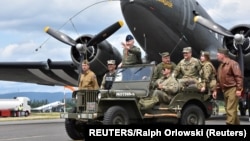During a meeting with Moscow State University students on January 25, Russian President Vladimir Putin claimed the United States had not ended its military “occupation” of Germany, which began in May 1945:
"After all, after the Second World War, Germany was, as you know, divided into four occupation zones: American, British, French, and Soviet. So, the Soviet Union legally ended the occupation, but the United States did not. Strictly speaking — technically, legally — there are American occupation troops in the Federal Republic of Germany. In fact, they are: there are a lot of them,” Putin said.
That statement is false. The military occupation of western Germany by the United States, the United Kingdom and France after World War II lasted a little less than 10 years, from 1945 to 1955.
After Germany surrendered to the Allies on May 8, 1945, the German state ceased to exist, and it was ruled by the victorious Allied powers.
The four main European allies, the U.S., U.K., Soviet Union and France, jointly occupied Germany in accordance with the June 5, 1945, Berlin Declaration on the defeat of Nazi Germany.
The Allied powers shared responsibility for administering Germany and its capital, Berlin, and each assumed responsibility for a certain part of the defeated country. The discussion of what to do with Germany began during World War II at the Allied leadership conferences. The U.S. Department of State described the history of these arrangements originating from the meetings between U.S. President Franklin Rosevelt and Soviet leader Josef Stalin:
“At the final wartime conference between these two men at Yalta in 1945, the two powers …determined that the occupation would divide Germany into sections, with each Allied power taking responsibility for one section, although they would be governed as a single economic unit in anticipation of their eventual reunification.”
While the U.S. and Soviet Union initially proclaimed plans for a reunited and independent Germany, with the start of the Cold War — geopolitical tension between the U.S.-led Western Bloc and the Soviet-led Eastern Bloc — it became apparent that each of the participants sought a reunited Germany allied with them.
The Western powers and the Soviet Union not only differed over how to deal with Germany as a nation-state, but also defined politics, security, democracy and economics in fundamentally different ways.
As a result, the Soviet Union used its own political and economic system as a model for East Germany and established it as an authoritarian communist regime with a planned socialist economy. The U.S., U.K. and France used their own political and economic systems as a model for West Germany and established it as a country with a democratic political system and a market economy.
In 1948, the Western powers instructed the West German federal states to write a democratic constitution. The Parliamentary Council of representatives of the state parliaments adopted the Basic Law of the new united West German state on May 9, 1949, and the Western allies approved it. On May 23, 1949, the Constitution of the Federal Republic of Germany came into force.
Elections were held in West Germany in August 1949 and the first German Bundestag (Federal Parliament) was formed the following month. Also in September 1949, the Federal Assembly, comprised of Bundestag members and delegates from the federal states, elected Theodor Heuss as the first federal president and Konrad Adenauer as the first federal chancellor.
Still, the Federal Republic of Germany did not yet have full sovereignty, with the Western allied powers retaining significant rights. For example, the Federal Republic of Germany initially did not have its own armed forces. It wasn’t until 1951 that West Germany established its first armed force – the Federal Border Guard.
The Federal Republic of Germany became fully independent on May 5, 1955, when the U.S., U.K. and France issued a proclamation announcing the end of almost 10 years of military occupation. West Germany subsequently established its own armed forces, the Bundeswehr, and resumed the production of weapons. However, it was forbidden from producing chemical, biological and atomic weapons.
The West German government’s proclamation marking end of the occupation of the Federal Republic of Germany, published in The New York Times on May 6, 1955, stated:
“Today, almost ten years after the military and political collapse of National Socialism, the occupation period ends for the Federal Republic. With deep satisfaction the Federal Government can affirm: We are a free and independent state. What has long been in preparation on the basis of growing trust has now become a legally valid fact: We stand as free men among free men, linked in true partnership with the former occupying powers.”
The Federal Republic of Germany joined NATO on May 6, 1955.
American troops remain in Germany as part of the country's NATO partnership, with the headquarters of the U.S. European Command in Stuttgart, Germany, and responsible for U.S. military relations with NATO and 51 countries and territories.
The presence of American troops in Germany has declined sharply since the end of the post-World War II occupation, from 1,622,000 in 1945 to 33,250 in 2018. The Bundeswehr has over 260,000 personnel.





